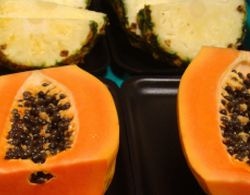Enzymes: Catalysts for Healthy Living

When a consumer proposes a toast before dinner, he may not be thinking about how that beer was fermented or how his body so easily digests the milk, bread and meat he is about to consume. If he did think about it, he may just want to raise his glass to enzymes.
Enzymes are the reason he can digest that meal and drink that beer. In fact, the discovery of enzymes is rooted in alcohols history. In the 19th century, Louis Pasteur found the fermentation of sugar to alcohol was catalyzed by a vital force contained within yeast cells. He called them "ferments," but in 1878, German physiologist Wilhelm Kühne was thinking more about bread yeast when he coined the term enzyme. In Greek, zyme meant leaven, so enzyme was to en-leaven the bread. While Pasteur thought ferments were only found in living yeast cells, Eduard Buchner found sugar was fermented even without living yeast cells in 1897. In 1907, Buchner was rewarded for his discovery with the Nobel Prize.
Enzymes are catalysts for biochemical reactions, meaning they speed up reactions using lower activation energy than would be necessary for the process to go on without the enzyme. Meat, for example, can sit out at room temperature and biodegrade over a few days; but, the enzymes in the digestive track can speed up that process, so humans can get all of the nutrients during the course of a day or so. Enzymes also have a unique shape, which allows a lock-and-key method with the molecules involved in their reactions. This means enzymes are highly selective, only causing specific reactions.
When enzymes take part in a biochemical reaction, they do not undergo permanent changes and, therefore, remain unaffected at the end of the reaction. This means they can repeat their actions multiple times within the body, unlike other vitamins and nutrients. For example one vitamin C molecule combats one free radical and must be consumed in the process. Enzymes, on the other hand, can continue to react with a specific type of molecule several times.
Another way enzymes are unlike vitamins is how they are measured. Mike Smith, vice president, Specialty Enzymes & Biochemicals Co., explained: Enzyme labeling is tricky, not only because there is no daily value, but because the actual milligram amount is practically meaningless. The essential measure of enzymes is by activity more so than weight. It is further complicated because there are many different ways to measure activity. In North America, we tend to use USP (United States Pharmacopeia) assays for animal source enzymes and FCC (Food Chemicals Codex) for plant, bacterial and fungal enzymes. There are some older assays that are still in common use such as gelatin-digesting units (GDU) for bromelain, SKB [Sandstedt, Keen and Blish units] for amylase and MCU [milk clot units] for papain.
While enzymes control most all of the physiological functions of life, they are mostly used in dietary supplements to aid digestion. Food processing starts with enzymes in the mouth in where salivary glands secrete carbohydrate digestive enzymes. In the gastrointestinal (GI) track, digestion continues with the secretion of hydrochloric (HCl) acid, the enzyme pepsin, and additional starch and protein hydrolases (another type of enzyme). Then, the small intestine secrets alkaline bicarbonate buffers and pancreatic enzymes to further the digestion process.
When these enzymes dont work correctly, GI abnormalities can result, including constipation, diarrhea, malnutrition, irritable bowel syndrome, dyspepsia, Crohns disease, maldigestion, malaria, cystic fibrosis, multiple sclerosis and cancer, to name a few. To help reduce these and other enzyme deficiency ailments, consumers may look to supplement their diets with enzymes.
Because supplemental enzymes support healthy digestion and may help maximize absorption of nutrients, consumers are discovering three key benefits of taking enzymes: addressing symptoms of poor digestion, improving nutrient absorption and, therefore, maximizing their food and nutrition budget, said Rodger R. Rohde Jr., president of Triarco Industries Inc.
Sales of natural products that address the root of the digestive problem, be it serious enough to cause hospitalization or only cause occasional discomfort, rather than mitigate the symptoms are increasing, said Judy Curtis, technical writer, and Nena Dockery, scientific and regulatory affairs manager, National Enzyme Co. In addition, customers have become more aware of some of the specific food-based causes of indigestion, including reactions to the gluten in wheat and the lactose in milk. These reactions can be reduced by taking the right enzyme, they said.
Smith noted, A large reason for the continued growth of enzymes is due to the fact they are one of the few dietary supplements in which you actually feel the positive effects.
Consumer interest is also driven by a sense of ownership of their digestive and overall health, said Deerland Enzymes CEO, Scott Ravech. No longer being completely satisfied with traditional physician-recommended or mainstream commodity supplements, consumers are finding that enzymes provide the benefits they are looking for across a host of human conditions, he said. Digestion, inflammation reduction and cardiovascular/circulatory health are a few examples of the more popular uses of enzyme supplementation.
Its true the health benefits of enzymes dont stop with digestion. Supplemental enzymes fall into one of two categories, digestive and systemic formulations. Systemic enzymes include every other health condition besides digestion, but tend to concentrate on cardiovascular and joint health. Smith explained: Digestion is obvious, though there are subcategories here. These include mainly general digestion, dairy, grains, legumes and, more recently, gluten, he said. The systemic enzymes are an exciting area of investigation. Systemic enzymes are predominantly protease enzymes. One of the oldest and best known is bromelain, which is derived from the stem of pineapples. Newer protease enzymes include nattokinase, serratiopeptidase and blended combinations that employ one or both of these with other proteases. These two enzymes, in particular, exhibit profound fibrinolytic as well as anti-inflammatory activity. The potential for use in inflammatory and cardiovascular conditions is significant.
A chief digestive enzyme is pepsin, which is secreted by the cells in the stomach lining and is one of the first protein digestive enzymes secreted in the GI tract beginning the hydrolytic process of protein catabolism. It converts protein foodstuffs into water-soluble material and degrades food proteins into peptides. Other pancreatic enzymes (amylase, lipase and protease) secreted by the acinar cells of the pancreas are the major digestive agents in the GI tract. These pancreatic enzymes digest starches, lipids and proteins to absorbable forms in the small and large intestine.
But when these enzymes arent working properly, humans dont digest they way they were designed to. Due to a variety of factors including diet, exercise or various health conditions, humans may decrease their ability to generate these enzymes, said Bret Wyant, sales representative, American Laboratories Inc. Enzyme supplements are then taken to help aid the body with the enzymes that should be naturally occurring but are lacking in some people.
Rohde added, One of the biggest myths there may be about digestion is that everything that you eat will be absorbed. The fact is that the bodys ability to absorb the foods, beverages and supplements that we take depends on our age, the quality of the product, what other products are taken with it, gastrointestinal transit time and so on. In order to benefit from the foods and nutrients we take in, we must break them down properly during digestion and absorb them.
Aminogen®, a patented, GRAS (generally recognized as safe)-affirmed enzyme system from Triarco is used to help protein digestion; Carbogen®, also from Triarco, targets complex carbohydrates; Legumase® targets the specific sugars in beans and other legumes; and the Agree® enzyme line targets foods known to be difficult to digest. The line includes formulas for each major food category, such as Agree® with Dairy, Agree® with Fruits and Vegetables, Agree® with Rich Foods and Agree® with Pasta and Potatoes.
P.L. Thomas offers GliSODin®, a superoxide dismutase (SOD) enzyme extracted from cantaloupe melon and delivered in combination with wheat gliadin. SOD fights oxidative stress, but is denatured (deactivated) during passage through the GI pathway. However, studies have shown combining SOD with a wheat gliadin biopolymer system temporarily protects the SOD during its passage through the GI tract.1 Use of GliSODin has shown a significantly lower levels of oxidative-stress induced DNA damage in mice.2 Humans who took GliSODin (20 men with an average age of 31) experienced no significant changes in DNA damage after being exposed to hyperbaric oxygen (HBO), pure oxygen at a pressure of 2.5 atmospheres, for 60 minutes, where the placebo group experienced significant damage.3 GliSODin has also shown to improve performance in athletes,4,5 reduce carotid artery intima media thickness (IMT), a sign of hardening of the arteries (atherosclerosis), in patients considered to be at risk of cardiovascular disease,6 and reduced skin-reddening when healthy fair-skinned volunteers were exposed to UV radiation.7
Enzymes come in all different types and delivery forms. The most popular delivery form seems to be capsules followed by tablets, due to their stability. Enzymes are most stable in powder form, Smith said. They become active once they go into solution. The down side of that is that they begin to denature over time and, as a result, a ready-to-drink beverage is not practical due to the short shelf life. Once an enzyme is denatured, it is simply an inactive protein.
Increasingly, enzymes are showing up in powdered blends used as is or designed to be added to liquids, as well as in chewable tablets. Rhode noted Aminogen can be added to protein snacks, bars and beverages while Carbogen is available in a multi-vitamin. Enzymes are also versatile, he continued. Ingredients like Triarcos Aminogen® and Carbogen® can stand alone as effective supplements, or combined with various foods and beverages for functionality. These ingredients can also be stacked with other ingredients to address and support specific digestive health issues, weight management, appetite control, healthy aging, energy, exercise recovery and more.
Anderson said GliSODin is even used in tea bags, and works, as long as it is consumed quickly after being exposed to water.
A capsule-in-a-capsule technology has also been introduced for delivering enzymes, which Ravech said allows a two-stage delivery with the ability to have a liquid product and a powered product delivered in the same capsule. These enteric coatings can also help enzymes reach the small intestine by shielding them from the stomachs harsh acidic conditions. After the enzymes are taken orally, the acidic fluid of the stomach dissolves the outer layer on the capsule and the enzymatic formula is released in the intestines.
Yoon-Mo Kang , vice president, CTC International, explained its enteric coating delivery system, called Innova Shield, is like a tennis ball with a golf ball inside in it, but much smaller. He said, The tennis ball (just shell) is full of gastric enzymes supposed to be dissolved in the stomach, whereas the golf ball is enteric coated enzymes, which are supposed to dissolve in the small intestine.
Manufacturers must try to ensure enzymes remain stable and bioavailable during formulation, which is not always easy. Enzyme proteins are usually globular and must retain the correct shape in order to react with molecules. However, changes in temperature and pH can affect the shape and denature enzymes. This optimal temperature is usually around human body temperature for the enzymes in human cells.
Time and temperature are our primary concerns, Wyant said. Short durations of high temperatures will not affect the enzyme activity, but heat treatment, tableting and irradiation can denature the enzyme proteins and reduce the activity and effectiveness.
Enzymes must also be stored correctly. Storage and handling of enzymes is very important, Smith said. The raw enzyme powder must be stored in a cool, dry place, tightly sealed and away from light to maintain maximum activity. If handled in this way, the enzyme will only lose minimal activity over the course of a year. He added capsules should be promptly bottled after formulation to maintain maximum activity.
Explaining the intricacies of enzymes down the retail chain will help shoppers purchase quality products, Ravech said. Retail chains that specialize in health and wellness and dietary supplementation often work in collaboration with their suppliers to educate their associates, he said. When associates have a better understanding of the benefits from the wide variety of supplement products (many of them enzyme based), consumers invariably become more educated as well. By partnering with their suppliers, these more forward-thinking companies are recognizing the value they can provide for their customers by understanding and being able to explain in great detail how the products work in the human body.
Ravech also said word-of-mouth among consumers is helping the enzyme market. Real-life assessments of the benefits that come from enzymes have created a surge in word-of-mouth marketing. This has a very positive impact in attracting new users and retaining consumers who are already experiencing true benefit from enzyme supplements.
Smith added consumers talking with each other about enzymes will help this market continue to grow. As long as antacids like Tums and H2 blockers like Pepcid are profitable, there is little incentive for major pharmaceutical corporations to market digestive enzymes, he said. The same applies to the systemic enzymes. As a result, enzymes will continue to grow as they have over the past two decades by word of mouth, recommendations from health practitioners open to alternative medicine and publications in the natural products industry.
Rhode said he sees growth of enzyme sales in the aging population market. People produce fewer of their own digestive enzymes as they age, and tend to experience increased indigestion, acid reflux, lactose intolerance, gas and bloating as a result. Enzymes can help support digestive comfort, healthy energy and nutrient balance in a way that many products do not. He added the science on enzymes is still in its infancy and as more positive research is published, sales will grow.
The proliferation of junk and processed foods, stressful environments and sedentary lifestyles will also help propel the market for digestive enzymes, said Curtis and Dockery, but they warn consumers need to be informed. The challenge, of course, is education, they said. The more we can educate customers and consumers, the more interested and trusting they will be of the power of enzymes to promote healthy, efficient and comfortable digestion.
Enzymes come in myriad forms and address myriad conditions. They are usually known for their digestive aids, but new research has found interesting health benefits to the heart, inflammation and more. However, to be effective, manufacturers must take care in their formulation processes to retain the stability and bioavailability. And, education is key. With an understanding of the way enzymes can help, the consumer may just raise his glass to these little catalysts that can start so many health benefits.
References
1. Clemente MG, et al. Early effects of gliadin on enterocyte intracellular signalling involved in intestinal barrier function. Gut. 2003 Feb;52(2):218-23.
2. Vouldoukis I, et al. Antioxidant and anti-inflammatory properties of a Cucumis melo LC. extract rich in superoxide dismutase activity. J Ethnopharmacol. 2004 Sep;94(1):67-75.
3. Muth CM, et al. Influence of an orally effective SOD on hyperbaric oxygen-related cell damage. Free Radic Res. 2004 Sep;38(9):927-32.
4. Arent S.M., et al. Nutritional supplementation in male college soccer players: effects on performance and oxidative stress Rutgers University. 2004
5. Arent S.M., Nutritional Supplementation (Glisodin® Containing Resurgex® Formula) In Male College Football Players: Effects On Strength, Body Composition And Oxidative Stress, Human Performance Lab, Rutgers University, New Brunswick, NJ. 2007.
6. Cloarec M., Caillard P., et al. GliSODin®, a vegetal SOD with gliadin, a preventative agents vs. athersclerosis, as confirmed with carotid ultrasound-B imaging European Annals of Allergy & Clinical Immunology, 2007, Volume 39, Number 2, Pages 2-7
7. Mac-Mary M., et al. Could a photobiological test be a suitable method to assess the anti-oxidant effect of a nutritional supplement (Glisodin®)? European Journal of Dermatology, 2007, Volume 17, Number 2
About the Author(s)
You May Also Like






.png?width=800&auto=webp&quality=80&disable=upscale)